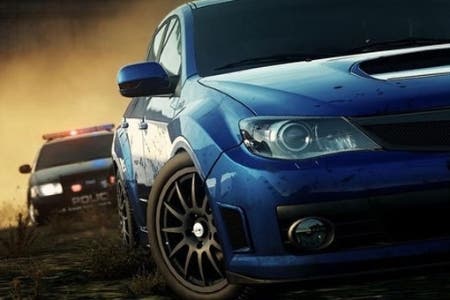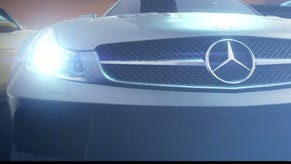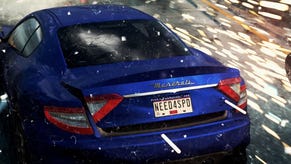Face-Off: Need for Speed: Most Wanted
Return to Paradise?
| - | Xbox 360 | PlayStation 3 |
|---|---|---|
| Disc Size | 3.6GB | 4.6GB |
| Install | 3.6GB (optional) | - |
| Surround Support | Dolby Digital | Dolby Digital, DTS, 5.1LPCM, 7.1LPCM |
The Need for Speed series' fortunes turned around to dramatic effect with 2010's Hot Pursuit - a technical marvel which added Criterion Studios' signature open-world sandbox design, and introduced its now widely-imitated Autolog feature. It was a daring game of cat and mouse across a dense city sprawl that necessitated some changes, however. The biggest was the abandonment of the fluid 60FPS response previously enjoyed by console Burnout Paradise players, where the focus switched to pushing for higher-detailed locations and effects at 30FPS. No doubt, a tough call to make for an arcade racer project, and one which gave the PC version more gravitas.
Today, the Guildford-based developer takes a similar tack with its latest offering, a re-envisioning of Need for Speed: Most Wanted, originally released at the very start of this generation. As a game design concept going on six years old, the hook of vying for the greatest notoriety in the city of Fairhaven is a sharp one. It's also backed up by a rigid technical baseline in the studios' modified Chameleon engine, which brings to life the congested city-centres, seaside beltways, and outskirt industrial complexes you'll be whipping past.
It's a big game and as if to add to the burden of development it also arrives as an ambitious multi-platform release with some extra tricks up the PC's sleeve. Console parity is a clearly taken as a serious matter of concern for the developer, given its impeccable reputation in delivering like-for-like image quality on performance on each. Here, we take a close look at the 360, PS3 and PC versions to see whether this high standard is being upheld across the board.
To get the ball rolling, we have our usual head-to-head video on offer below, made up of the many lucid - and frankly, sometimes nightmarish - cut-scenes that come up before each race. For those who might prefer stills, there's a lengthy triple format comparison gallery for you to browse through too.
"First impressions confirm that Criterion has once again handed in an extremely close cross-platform project, with plenty of additional PC bling if you have the horsepower to cope with the additional load."
Alternative comparisons:
- Need for Speed: Most Wanted - Xbox 360 vs. PC
- Need for Speed: Most Wanted - PS3 vs. PC
Cut-backs have been made to the resolution on consoles, though they are slight. The actual visible output on PS3 and 360 is trimmed down to 1280x704 apiece, where 8 pixel high borders can be spotted at the top and bottom of the screen. Thankfully no upscaling is involved here to stretch this frame-buffer to the full-screen which might have muddied the image quality. But instead, the margins are kept small enough to blend in with the black borders of most HDTVs (or else vanishing into the overscan area) making it unnoticeable unless compared with the PC release. A similar tactic is employed by Battlefield 3 to save on memory bandwidth, which can be a hog for games using various advanced rendering features.
The PC version we have running is set to the full-fat visual experience; we have the high resolution texture pack enabled, with reflections, shadow detail, motion blur and geometry detail all set to high. Interestingly, despite the wealth of options here, we're not trusted to choose our own form of anti-aliasing from the in-game menu, nor with a discrete tweak to its config file. Instead we have a post-process AA method applied as a permanent fixture, which looks identical in practise to the implementation on PS3 and 360 - this is no doubt owing to the Chameleon engine's full deferred rendering set-up. It clears up the sharp edges efficiently enough, but the way it blurs over texture detail strongly points to the residual effects of FXAA, and may not be to everyone's taste.
This could be a nuisance of PC owners used to "rolling their own" visual experience; a clearer picture counts as one of the big boons of playing on the format, but racing through Fairhaven produces an image that looks slightly blurred regardless of your set resolution - an improvement over the console releases, but not quite living up to the dream. Even so, the option to raise the pixel count does still make it much easier to spot upcoming cars, road divides and bollards on PC, which can make for a life or death difference during 120MPH races through busy city streets.
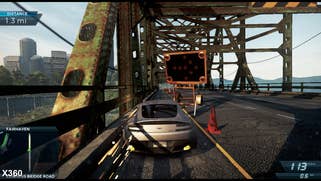
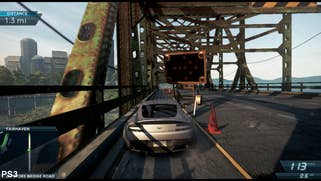

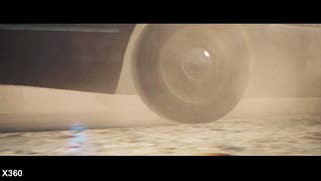
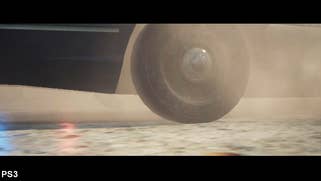
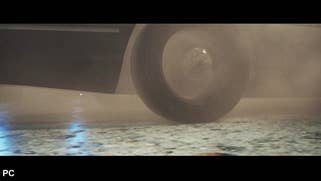





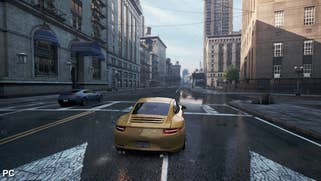
As far as asset quality goes, Criterion presents practically like-for-like results across both 360 and PS3. It's really to the studios' credit that this has been possible, though we do see one strange omission in play on Sony's console. Curiously, friction sparks don't appear in full-force when grinding against metal rails on PS3, despite accelerating full throttle into them during matching intro sequences. Activating patch v1.01 initially resumes these particle effects without any apparent performance penalty, but on subsequent playthroughs they go missing again - a very odd quirk that doesn't present itself on the 360 side.
Most Wanted can move very quickly indeed, particularly once you're zooming across terrain with multiple nitrous boosts. As a result, streaming of geometry and texture assets forms a crucial part of the engine's design, and without an effective culling algorithm, it would fall flat. In playing the console versions, it's apparent that grass tufts, light sources, and reflected elements are handled with a lesser priority, though this is acceptable given that they're largely aesthetic elements. We see plenty of reflected details popping in on the ground when riding at high-speeds on console, for example, but it's rare that we can spot actual buildings or cars suddenly emerging from nowhere on the horizon.
On the point of streaming, it bears mention that Most Wanted works around any kind of mandatory install for PS3, and does so without so much as a stutter. It's a respectable effort to avoid over-encumbering new 12GB Super Slim model owners with too much data. However, the off-shoot of this approach is that loading times are noticeably longer on boot-up than that of the 360's. In timing each, we find a cold boot with no prior saves takes the 360 version installed to HDD 20 seconds to reach the first CG cut-scene, while our new PS3 takes 49 seconds in total. Not ideal.
"Hot Pursuit was a fairly basic PC port - Most Wanted shows that Criterion has upped its game significantly and it's the only choice for precision 60FPS action."
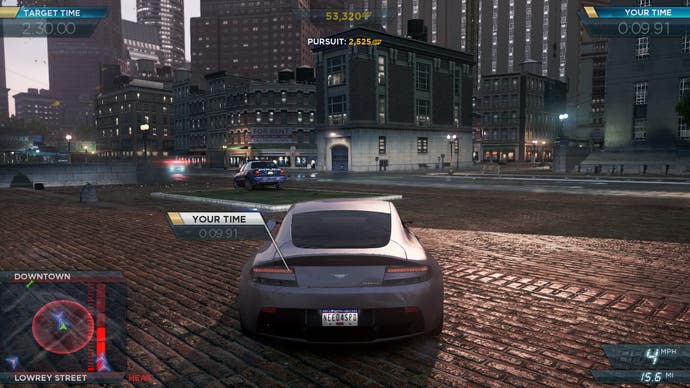
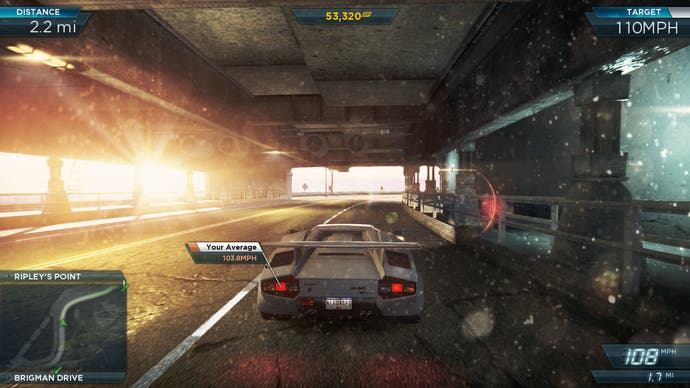
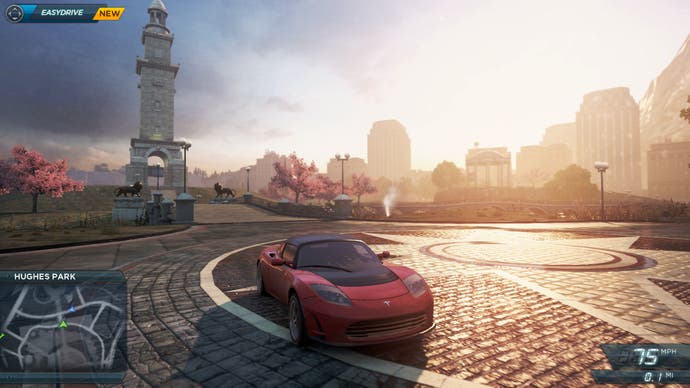
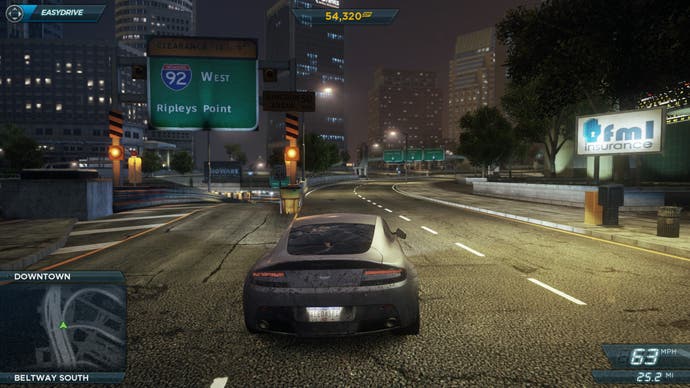
Having an optional install might have been a good idea in this case. It affects the run of play too, where loading a race like Keys to the City takes Sony's platform almost twice as long, at 15 seconds, as compared to just eight seconds on 360. These accordingly longer waits on PS3 can add up over the course a single play-through - though thankfully, once the data is cached, retrying a race directly from the menus cuts these loading times down significantly. [Update: Caching information added.]
Need for Speed: Most Wanted - performance analysis
In the arena of performance, Criterion Studios has in recent times opted for a lower update in favour of a superior lighting engine. The switch from 60FPS to 30FPS for Hot Pursuit surprised some in particular, since the racing genre by and large benefits from a higher frequency of visual updates. Fortunately, the Chameleon engine's single-threaded model meant that controller lag could be minimised to just 83ms when optimised - not too far off from the 67ms we see from the majority of 60FPS games (including Burnout Paradise).
As for Most Wanted, there's little difference in the nature of controller response compared to the last release; it remains a 30FPS game, and strictly upholds v-sync throughout cut-scenes and gameplay alike. To catch any differences between the 360 and PS3 versions in their tracks, we take like-for-like captures of each platform running the game's bizarre intro sequences. Plus, to get an idea of how identical in-game footage performs, we have the cars ride straight forward for as long as we can hold off smashing into a wall.
"The excess of alpha effects is apparently at the heart of the frame-rate problems when they arise, and despite being rendered at a lower resolution, causes both platforms to drop at around the same points."
Similar to Hot Pursuit, we see the game lock to 20FPS at the very worst during certain sequences, but for much of the way it's a solid, smooth line. The excess of alpha effects is apparently at the heart of the problem when it arises, and despite being rendered at a lower resolution, causes both platforms to drop at around the same points. We see two more dips from the 360 overall here when smashing through lamp-posts, largely coinciding with physics-based demands, but these are very rare instances indeed. It's a strong showing overall, and for in-game moments we only see frames being dropped at the start of the Continental Drift lapped race with seven other cars.
This doesn't give us a very good picture of how the game actually plays, however. For a broader perspective, we rev up our virtual Porches and Aston Martins to get the low-down on unsynchronised performance.
As a rule, performance is yet again locked to 30FPS with v-sync engaged indefinitely. There's no sign of either console really buckling until the Burning Rubber stage, where our first lap through the city streets takes us around a bend with plenty of exhaust fumes flying towards the screen. Starting out last in the pack also reveals how each platform reacts to multiple cars being on-screen at once. In this case, it's the PS3 that comes out on top, where the 360 noticeably dips on three occasions to the sight of rival cars ramming into one another.
"Starting out last in the pack also reveals how each platform reacts to multiple cars being on-screen at once. In this case, it's the PS3 that comes out on top, where the 360 noticeably dips at certain points."
Turning our attention to PC performance, we hope to push straight past these performance woes, and do whatever it takes to establish a locked 60FPS. Alas, running Most Wanted at maximum settings doesn't give us the silky-smooth feedback we were hoping for on our high-end setup. The PC is equipped with an Intel i5-2500K processor overclocked to 4.2GHz, plus a GTX 670 graphics card, but still suffers sustained dips to the low 50s when passing through city centres. The most immediate workaround is to drop the shadow detail to medium.
To get an idea of how it might perform on a budget setup, however, we run the game at 1366x768 and 1920x1080 resolutions on our £300 Digital Foundry PC. Sharp turns in big congested cities, alongside collisions with objects on the side-walk, bring the frame-rate down to 50FPS even when all graphics settings are set to low. This makes a perfectly crisp 60FPS lock out of the question when shooting for 1080p but 768p manages to at least keep on track for much of play.
Shadows are the bottleneck once again, and though it leaves the environments looking slightly plain, the only way to optimise the frame-rate is to disable them altogether. While our setup defaults to low settings all-around, we can actually get away with raising reflection, VFX detail and ambient occlusion settings to high once this is done. The high resolution texture pack can also be added without incurring a noticeable drop, giving us the best image possible while targeting 60FPS.
It's not perfectly smooth, then, but it's possible. For those willing to settle for higher visual quality, there's a 'LockTo30' variable up for grabs in the game's config file which helps keep 1080p performance pegged at that number. It plays surprisingly well and the overhead is as such that we can even reinstate shadows without dropping below it.
Need for Speed: Most Wanted - the Digital Foundry verdict
In summary, Criterion's latest racer takes the advanced lighting of its predecessor, improves upon it still further and once again builds up a varied sandbox world around the premise of the original Need for Speed: Most Wanted. As an ongoing game of cat and mouse, the need to embed as much detail into Fairhaven as possible could so easily have been at odds with the blazing speeds at which you zip across the terrain. Fortunately, the world streams in smoothly on both consoles for this final build, with the only real blemish being the pop-in for reflected elements.
"The PC release has the greatest flexibility to solve the quirks of the console versions and it does so while adding options for higher resolution textures, smoother shadows, and more complex geometry into the mix."
Naturally, the PC release has the greatest flexibility to solve this quirk and it does so while adding options for higher resolution textures, smoother shadows, and more complex geometry into the mix. As for the contention between 360 and PS3, we see image quality is practically identical even under close scrutiny, save for the curious paring back of particle effects on Sony's console when colliding with barriers. Otherwise, the biggest differences in direct screen comparisons come about purely as a result of the game's rapid day-night cycle - something we couldn't compensate for in our comparison assets.
In terms of that crucial playability factor, the PS3 wins out by a close margin in our performance tests, though neither is a particular let-down in delivering on the v-synced 30FPS target. Perhaps a larger issue would be the length of the loading screens on each platform, where the 360 can ready the game's levels twice as quickly as the rival console when installed to the HDD. This may come as a salient point for those entering every race in sequence, as and when a new car discovery unlocks them.
But much like DICE's Battlefield 3, it's the PC version of Most Wanted that ultimately serves as the reference point for technical design - even though powerful kit is required to show this game running at its absolute best. The console versions run at graphical settings equivalent to the PC's lowest in most regards, most noticeably with the pixellated alpha effects that crop up. The PS3 and 360 offerings are eminently playable, but more than ever, the challenges Criterion faced in fulfilling the game's visual potential shows a need for fresh, new console hardware.
